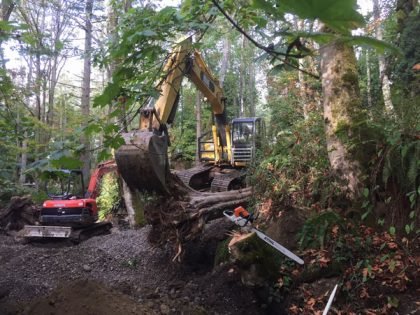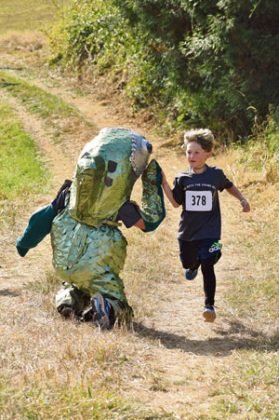 Birch Bay Watershed and Aquatic Resources Management District and Nooksack Salmon Enhancement Association staff restoring approximately 400 feet of stream channel between Brown and Aldergrove roads in 2017. Photo by Darrell Gray from NSEA
Birch Bay Watershed and Aquatic Resources Management District and Nooksack Salmon Enhancement Association staff restoring approximately 400 feet of stream channel between Brown and Aldergrove roads in 2017. Photo by Darrell Gray from NSEA
By Stefanie Donahue
After nearly two decades of effort to restore water quality in the Birch Bay watershed, local environmental advocates let out a collective sigh of relief – on January 16, the Washington State Department of Health lifted harvesting restrictions on 129 acres of Birch Bay shellfish beds due to
reduced levels of pollution.
The effort to restore water quality in Birch Bay began after questions emerged about the health of Terrell Creek. The creek drains from Lake Terrell and courses about nine miles through rural, farm and residential areas, gathering fecal coliform bacteria from a variety of sources and carrying it into Birch Bay. In addition to the pollution, a 1999 habitat assessment conducted by the Nooksack Salmon Enhancement Association (NSEA) identified multiple problems hindering successful salmon spawning.
Volunteers and various agencies worked together to improve and restore the creek’s water quality and salmon habitat; among them, NSEA, Whatcom Conservation District, Birch Bay Watershed and Aquatic Resources Management District (BBWARM), Chums of Terrell Creek, Whatcom County Public Works, Whatcom County Marine Resources Committee, Environmental Protection Agency, Whatcom County Health Department as well as nearby property owners, including BP, Washington Department of Fish and Wildlife and Washington State Parks as well as other private owners.
Since 2003, volunteers have participated in regular work parties to plant over 27,000 plants, restore the creek’s riparian zone and install 5,729 feet of fencing. In addition to planting native trees and shrubs, volunteers have also educated nearby landowners – particularly small hobby farmers – about best management practices to prevent effluent runoff. Community groups have also come together to evaluate septic systems, use of beachside public restrooms and use of marina pump-out stations. Pollution from animal waste was also reduced through improved manure storage, added plants and pet waste pick-up.
 A runner passes a friendly fish during Run with the Chums in 2017. Photo by Abby of Dynamite Images
A runner passes a friendly fish during Run with the Chums in 2017. Photo by Abby of Dynamite Images
Issues related to water quality protection and improved stormwater management were addressed in the Birch Bay Community Plan, which was developed by community members in 2004. Concurrently, Birch Bay resident Gerald “Jerry” Larson led in the creation of the Whatcom County Marine Resources Committee’s clam survey and water monitoring programs to recover healthy shellfish populations. In 2007, BBWARM was created in response to community concerns about water quality, flooding and loss of aquatic habitat in the Birch Bay watershed. Subsequently, there have been seven stormwater capital improvement projects.
Despite the progress, areas surrounding Birch Bay’s tributary closed indefinitely to shellfish harvesters in 2008 due to high levels of fecal coliform bacteria. The following year, the Whatcom Conservation District received funding from the Environmental Protection Agency to, in part, implement a Terrell Creek Landowner Stewardship Program to provide technical and financial assistance to landowners. Other community outreach efforts, including the annual Run with the Chums 5K and Fun Run, ensued.
For volunteers, the January announcement by the state department of health this month was a huge step forward.
“The lifting of the shellfish harvesting closure at the mouth of Terrell Creek due to improved water quality means a great deal to the community members who advocated for the creation of a stormwater management district and protection of water resources in Birch Bay,” said BBWARM program specialist Holly Faulstich. “We are proud of the work our program and partners have accomplished over the past decade to reach the goal of open shellfish beds for the community to enjoy.”
BBWARM advisory committee chair Peter Winterfeld said it’s important for everyone living in the Birch Bay watershed to be conscious of the damage fecal matter can produce.
“Residents have volunteered to take water samples all around the bay and we are seeing improvements,” he said. “Surface water drains have been repaired and a bio swale has been installed in one of the most polluted outflow system. BBWARM has drafted a plan to repair systems. As money becomes available we will continue to improve reducing fecal matter and other pollutants.”
To learn more about Birch Bay water quality programs, visit bit.ly/2qdta0A.
Comments
No comments on this item Please log in to comment by clicking here